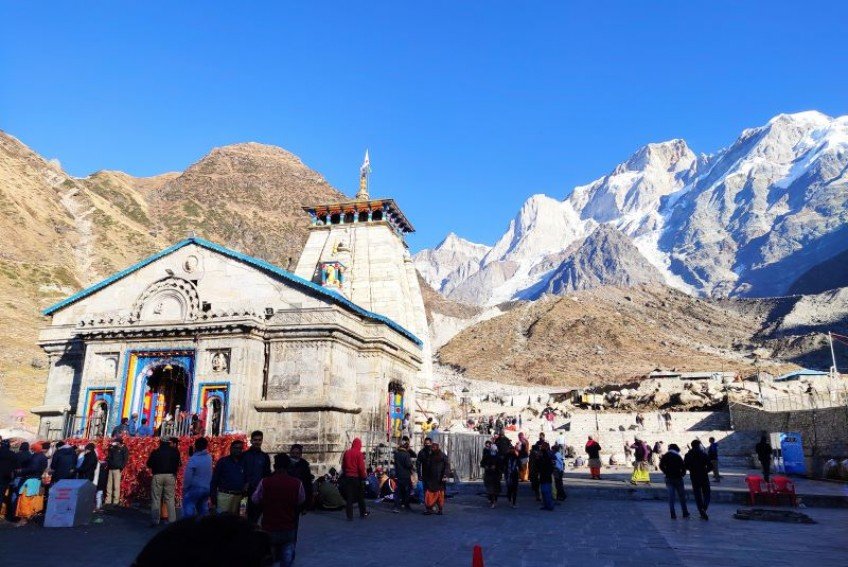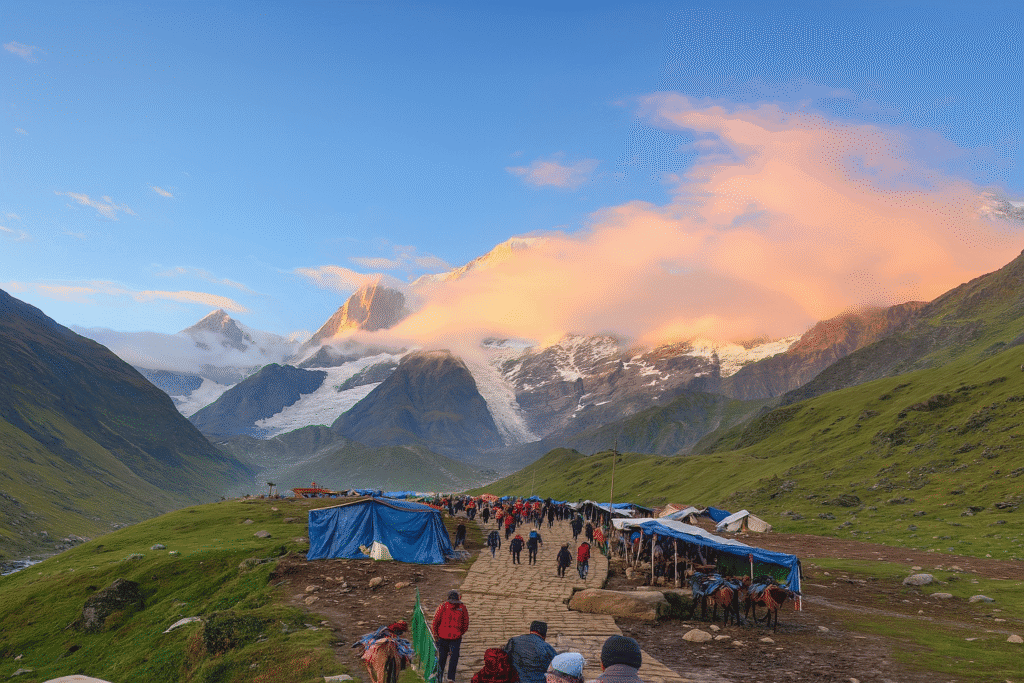Kedarnath Yatra is considered as a most honorable of the pilgrimages in India. It is visited by hundreds of thousands of pilgrims and tourists each year. Kedarnath, a shrine dedicated to Lord Shiva, is one among four holy pilgrimage centers situated in the mountain ranges of Garhwal region in Uttarakhand. It is one of the sites of the Char Dham Yatra. In addition to its religious importance, it offers an unforgettable mix of religion, nature, and adventure.

Historical and Spiritual Significance
In a legend, the temple is believed to have been constructed by Pandavas, the characters of the Hindu epic Mahabharata, to atone their sins committed during the “Kurukshetra” war. The temple, subsequently rebuilt by Adi Shankaracharya in the 8th century, remains intact to this day at an elevation of 3,583 metres. We are told that for devotees, a visit to Kedarnath is life transforming as it purifies ones soul and helps attain spiritual liberation.
Opening and Closing Date
The temple opens generally in the month of April or May on the day of festival of Akshaya Tritiya. It remains open through Kartik Purnima in November. In winter, the idol of Lord Shiva is led back to Ukhimath for worship. For Kedarnath Yatra 2026 pilgrims should call official Kanwar samiti number and confirm the opening date, trek route news & Registration date before start their journey.
How to Reach

The trip to Kedarnath is adventurous and demanding.
By Air: Jolly Grant Airport in Dehradun is the closest airport. From there, you can go by road to Sonprayag or Gaurikund.
By Train: The nearest railway station is Rishikesh railway station, approximately 210 km away from Gaurikund.
By Road: There are regular buses and taxis from the major towns of Uttarakhand to Sonprayag. Pilgrims will have to carry on the trek from Gaurikund, which is the last vehicle point.
The Trek Experience

The trek from Gaurikund to Kedarnath is approximately 16 kilometers. Pilgrims may walk this route or opt for riding ponies, hiring palkis, or using a helicopter. The route provides breathtaking scenery of snow-covered peaks, waterfalls, and valleys that foster devotion and awe. Proper preparation is essential, as the route is steep and the weather can turn unpredictable.
Registration and Permits
All pilgrims are required to go through compulsory registration for Kedarnath Yatra. The same can be done online via the official portals of the Uttarakhand government or on counters en route. One needs to carry valid ID proof. Registration assists officials in keeping everyone safe and controlling crowds.
Best Time to Visit
May, June, and September are the best months for Kedarnath Yatra. In the monsoon season of July and August, landslides and heavy rains make it risky to travel. Autumn is blessed with clear skies, picturesque views, and pleasant weather for trekking..
Accommodation Options
Kedarnath has a range of accommodations. You may opt for government guest houses and dharamshalas, as well as private hotels in surrounding towns like Guptkashi and Sonprayag. Advance booking is advisable during peak season. Several pilgrims also prefer to live in basic lodges and tents close to the temple for a spiritual feel.
Essential Travel Tips
- Pack warm clothing, rain equipment, and comfortable trekking boots.
- Carry basic medications, as altitude sickness may result in breathing difficulties for some travelers.
- Do not litter and maintain respect for nature and local culture.
- Keep informed about weather conditions and take advice from the local government.
- It is advisable to take travel insurance for safety on the high-altitude trek..
Beyond Kedarnath, Nearby Attractions
Pilgrims usually continue their journey to other holy and scenic spots within the vicinity of Kedarnath, including:
Guptkashi is well known for the Vishwanath Temple and its scintillating views of the Himalayas.
Tungnath and Chopta are a trekker’s dream destination and one of the Panch Kedar temples.
Chorabari Tal, or Gandhi Sarovar, is a peaceful glacial lake near Kedarnath.
Triyuginarayan Temple is referred to as the wedding location of Lord Shiva and Goddess Parvati.
Why Kedarnath Yatra is Special

Kedarnath Yatra is not only a religious trek; it is an endurance test, test of faith, and test of devotion. Treking in the midst of giant mountains, listening to “Har Har Mahadev” in the air, and seeing the ancient temple up close sends a rush of divine energy through one’s heart. For some, the pilgrimage is a once-in-a-lifetime opportunity to experience spirituality and nature at its most unadulterated form.
Kedarnath in Char Dham Yatra
The Kedarnath temple is a significant component of the Char Dham Yatra in Uttarakhand. The other temples of the pilgrimage are Badrinath, Gangotri, and Yamunotri. A lot of devotees feel that completing this pilgrimage leads to salvation and eternal peace. Kedarnath is the most challenging of the four dhams due to its high elevation and challenging trek. It is usually considered the final test of devotion and faith.
Cultural Experience Along the Yatra
The pilgrimage is also a cultural outing. The local Garhwali customs, folk songs, and the villagers’ warm hospitality make the yatra memorable. Pilgrims find mountain bazaars that offer woolens, spiritual trinkets, and herbal medicines. The simplicity of life of the local people and their strong faith add an air of humility and spirituality.
Safety and Health Precautions
Due to its high-altitude position, the Kedarnath trek requires physical endurance and mental preparedness. Trekkers should:
- Acclimatize properly prior to commencing the trek.
- Not take alcohol or smoke as it can aggravate altitude sickness.
- Bring dried fruits, water, and energy bars for the trek.
- Travel in groups or avail guided services for safety purposes.
- Stick to instructions given by disaster management teams, particularly in volatile weather.
Environmental Awareness
Kedarnath attracted international attention when it suffered the devastating floods of 2013. Authorities have ever since put great emphasis on eco-sensitive tourism. Pilgrims are urged to go plastic-free, dispose of their waste properly, and treat the delicate Himalayan environment with care. Sustainable travel ensures that the holy landscapes remain clean for generations to come.
Modern Facilities and Connectivity
Over the past few years, the Uttarakhand government has enhanced facilities near Kedarnath. Helicopter facilities, improved trekking routes, pony facilities, and mobile connectivity make it all that bit more comfortable for pilgrims. The temple complex has also been renovated.
Frequently Asked Questions (FAQs)
Q1. How many days are needed for the Kedarnath Yatra?
Typically, 5 to 7 days are required if you count travel, relaxation, and the return trip.
Q2. Can seniors visit Kedarnath?
Yes, subject to medical clearance. They can take palkis, ponies, or helicopter services to bypass the trek.
Q3. Is it safe to go to Kedarnath in 2026?
Yes, with improved infrastructure, registration mechanisms, and disaster management teams, the pilgrimage is safer than ever. However, pilgrims must skip the peak monsoon months.
Q4. How do I get helicopter tickets for Kedarnath?
Tickets can be reserved on official government-approved websites and counters. Reserving ahead of time during peak season is advisable.


